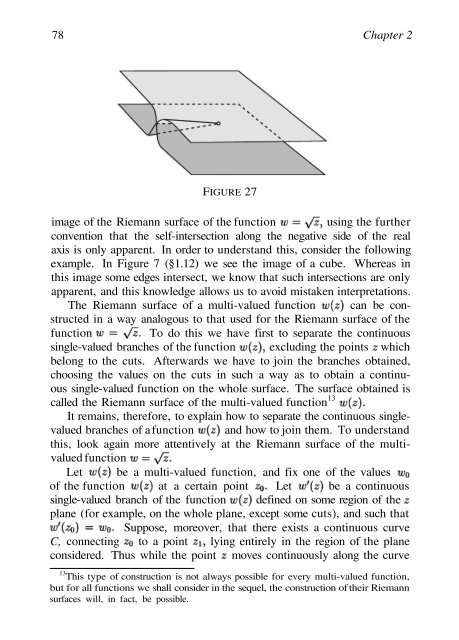Abel's theorem in problems and solutions - School of Mathematics
Abel's theorem in problems and solutions - School of Mathematics
Abel's theorem in problems and solutions - School of Mathematics
Create successful ePaper yourself
Turn your PDF publications into a flip-book with our unique Google optimized e-Paper software.
78 Chapter 2<br />
FIGURE 27<br />
image <strong>of</strong> the Riemann surface <strong>of</strong> the function us<strong>in</strong>g the further<br />
convention that the self-<strong>in</strong>tersection along the negative side <strong>of</strong> the real<br />
axis is only apparent. In order to underst<strong>and</strong> this, consider the follow<strong>in</strong>g<br />
example. In Figure 7 (§1.12) we see the image <strong>of</strong> a cube. Whereas <strong>in</strong><br />
this image some edges <strong>in</strong>tersect, we know that such <strong>in</strong>tersections are only<br />
apparent, <strong>and</strong> this knowledge allows us to avoid mistaken <strong>in</strong>terpretations.<br />
The Riemann surface <strong>of</strong> a multi-valued function can be constructed<br />
<strong>in</strong> a way analogous to that used for the Riemann surface <strong>of</strong> the<br />
function To do this we have first to separate the cont<strong>in</strong>uous<br />
s<strong>in</strong>gle-valued branches <strong>of</strong> the function exclud<strong>in</strong>g the po<strong>in</strong>ts which<br />
belong to the cuts. Afterwards we have to jo<strong>in</strong> the branches obta<strong>in</strong>ed,<br />
choos<strong>in</strong>g the values on the cuts <strong>in</strong> such a way as to obta<strong>in</strong> a cont<strong>in</strong>uous<br />
s<strong>in</strong>gle-valued function on the whole surface. The surface obta<strong>in</strong>ed is<br />
called the Riemann surface <strong>of</strong> the multi-valued function 13<br />
It rema<strong>in</strong>s, therefore, to expla<strong>in</strong> how to separate the cont<strong>in</strong>uous s<strong>in</strong>glevalued<br />
branches <strong>of</strong> a function <strong>and</strong> how to jo<strong>in</strong> them. To underst<strong>and</strong><br />
this, look aga<strong>in</strong> more attentively at the Riemann surface <strong>of</strong> the multivalued<br />
function<br />
Let be a multi-valued function, <strong>and</strong> fix one <strong>of</strong> the values<br />
<strong>of</strong> the function at a certa<strong>in</strong> po<strong>in</strong>t Let be a cont<strong>in</strong>uous<br />
s<strong>in</strong>gle-valued branch <strong>of</strong> the function def<strong>in</strong>ed on some region <strong>of</strong> the<br />
plane (for example, on the whole plane, except some cuts), <strong>and</strong> such that<br />
Suppose, moreover, that there exists a cont<strong>in</strong>uous curve<br />
C, connect<strong>in</strong>g to a po<strong>in</strong>t ly<strong>in</strong>g entirely <strong>in</strong> the region <strong>of</strong> the plane<br />
considered. Thus while the po<strong>in</strong>t moves cont<strong>in</strong>uously along the curve<br />
13 This type <strong>of</strong> construction is not always possible for every multi-valued function,<br />
but for all functions we shall consider <strong>in</strong> the sequel, the construction <strong>of</strong> their Riemann<br />
surfaces will, <strong>in</strong> fact, be possible.

















